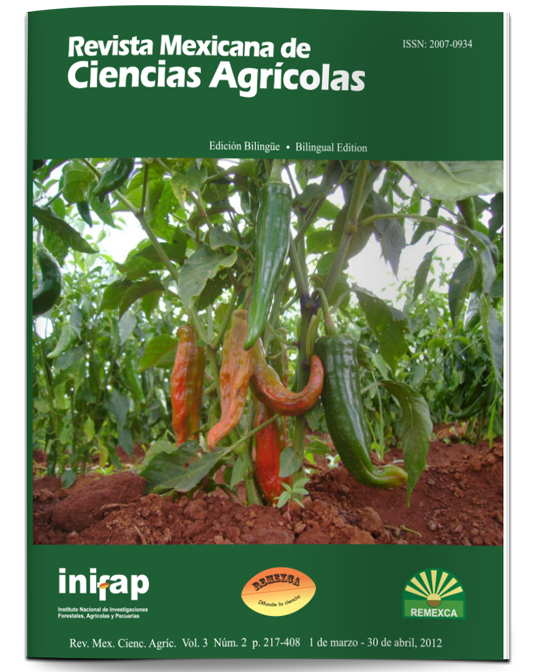Alternatives for the control of powdery mildew (Oidium sp.) in cucumbers (Cucumis sativus L.)
DOI:
https://doi.org/10.29312/remexca.v3i2.1461Keywords:
Oidium, cucurbits, phytomineralotherapyAbstract
This research was conducted to know the effect of phosphorous and potassium salts in the growth and control of powdery mildew (Oidium sp.) in cucumbers. Cucumber plants of the variety Poinset 76 with signs of the disease were sprayed with potassium bicarbonate, sodium bicarbonate, monopotassium sulphate, potassium nitrate, potassium chloride and potassium phosphite solutions. The application of salts showed no significant effects (p≤ 0.05) on the height and number of leaves of plants evaluated. With potassium phosphite, the incidence of the disease varied between 27.9 and 32.4%; with potassium bicarbonate, it was between 19.9 and 29.5%, and in the control, variation went between 44.1 and 47.4%. Twenty-six days after the first application (dda), plants treated with potassium bicarbonate and potassium phosphite showed 67.7 and 62.0% less severity than the controls. Forty-two dda with potassium bicarbonate and potassium phosphite, there was 49.4 and 44.5% less severity than in the control. Results showed that the potassium phosphite and potassium bicarbonate at 5 and 4.7 g L, respectively, reduced signif icantly (p≤ 0.05) the incidence and severity of the disease.
Downloads
Downloads
Published
How to Cite
Issue
Section
License
The authors who publish in Revista Mexicana de Ciencias Agrícolas accept the following conditions:
In accordance with copyright laws, Revista Mexicana de Ciencias Agrícolas recognizes and respects the authors’ moral right and ownership of property rights which will be transferred to the journal for dissemination in open access. Invariably, all the authors have to sign a letter of transfer of property rights and of originality of the article to Instituto Nacional de Investigaciones Forestales, Agrícolas y Pecuarias (INIFAP) [National Institute of Forestry, Agricultural and Livestock Research]. The author(s) must pay a fee for the reception of articles before proceeding to editorial review.
All the texts published by Revista Mexicana de Ciencias Agrícolas —with no exception— are distributed under a Creative Commons License Attribution-NonCommercial 4.0 International (CC BY-NC 4.0), which allows third parties to use the publication as long as the work’s authorship and its first publication in this journal are mentioned.
The author(s) can enter into independent and additional contractual agreements for the nonexclusive distribution of the version of the article published in Revista Mexicana de Ciencias Agrícolas (for example include it into an institutional repository or publish it in a book) as long as it is clearly and explicitly indicated that the work was published for the first time in Revista Mexicana de Ciencias Agrícolas.
For all the above, the authors shall send the Letter-transfer of Property Rights for the first publication duly filled in and signed by the author(s). This form must be sent as a PDF file to: revista_atm@yahoo.com.mx; cienciasagricola@inifap.gob.mx; remexca2017@gmail.
This work is licensed under a Creative Commons Attribution-Noncommercial 4.0 International license.



